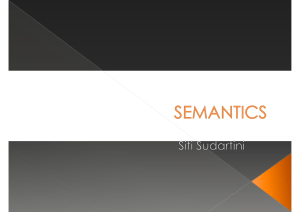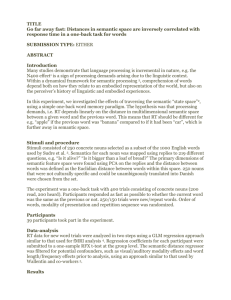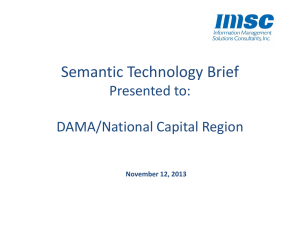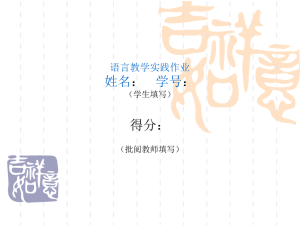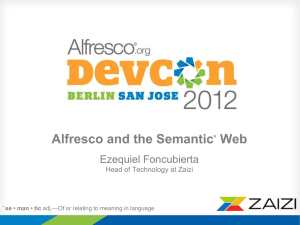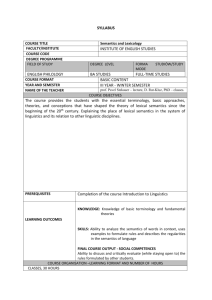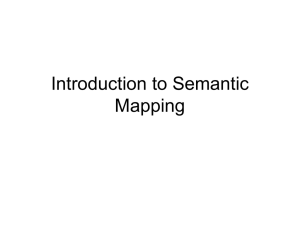stress
advertisement
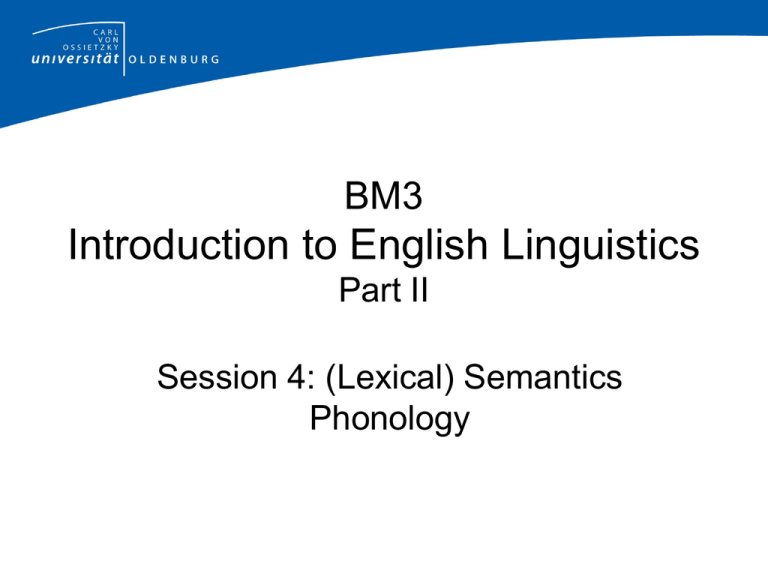
BM3
Introduction to English Linguistics
Part II
Session 4: (Lexical) Semantics
Phonology
REBECCA CARROLL
Contact options:
• A 10 1-103
mail box across the hall (A10)
• phone 0441-798 3181
• Email: rebecca.carroll@uni-oldenburg.de
All information can be found on my homepage:
www.staff.uni-oldenburg.de/rebecca.carroll
Overview:
•
•
•
•
•
•
Where are we?
Phonetics/ Phonology
Morphology
Syntax
Semantics
Pragmatics
Applied Linguistics
(Historical Linguistics, Sociolinguistics, Textlinguistics,
Psycholinguistics, Neurolinguistics, Computational
Linguistics, …)
Phonology ctd.
stress
weak forms
connected speech
Literature
Fromkin, V., Rodman, R., Hyams, N. (2006). An Introduction to
Language. 8th ed. Wadsworth.
Handke, J. (2001). The Mouton Interactive Introduction to
Phonetics and Phonology. CD ROM. DeGruyter.
Handke, J. & Intemann, F. (2000). The Interactive Introduction
to Linguistics. CD ROM. Version 2.0. München: Hueber.
See Handapparat for further introductory books
IPA Font
• Download fonts to use for transcription in portfolio:
Doulos SIL Font:
http://www.sil.org/computing/catalog/show_software.asp?id=91
– Download/ install to your fonts folder
– Choose font in your text document
– Insert symbols (or define a key combination as short
cut)
Connected Speech
• Pronunciation of individual words changes in
context
• Depending on the sentence stress, some
words are „weakened“ (so-called weak forms)
• Assimilation, elision & linking of sounds (at
word boundaries)
Stressed out about stress?
• Stressed = more „effort“ (amplitude, pitch, length)
• perception: relatively greater prominence
• change in stress = change in vowel quality (?)
Compare: Canada
/ˈkænəˌdɑː/ to /kəˈnɑˌdɑː/ to /ˌkænəˈdɑː/
Stressed out about stress?
• primary stress: / ˈ /
as in /əˈbaʊt/, /ˈbeɪ.sɪk/, /bəˈnæ.nɑ/
• secondary stress: /ˌ /
as in /ˌlɪŋˈɡwɪs.tɪks/,
/ˈaɪsˌkɹiːm/ vs. /ˌaɪˈskɹiːm/
‿
Weak Forms
• Appear in unstressed (monosyllabic?) words
• Often function words and pronouns
• Vowel reduced to more central tongue position:
/ə/ and /ɪ/
• Compare list of BE and AE weak forms
Assimilation
• „A phonological process whereby a sound
becomes phonetically similar to a neighboring sound.[…]“
Finegan (1999), p.586
• e.g. don‘t be silly (BE)
/ˌdəʊnt bɪ ˈsɪli/ /ˌdəʊm bɪ ˈsɪli/
• e.g. horseshoe (AE)
/ˈhɔɹzˌʃuː/ /ˈhɔɹsˌʃuː/ /ˈhɔɹ‿ˌʃuː/
Other examples {in-} im-perfect; il-legal
Linking
• Absence of a „gap“ between words
Resyllabification
• These are old eggs
– /ˈðiːz ɑɹ ˌoʊld ˈegz/ /ˈðiː‿zɑ‿ˌɹoʊl‿ˈdegz/
• Linking R (BE): a postvocalic /r/ that would
normally not be pronounced in non-rhotic
varieties is pronounced when it occurs between
two vowels: /hɪə‿ɹ‿ən‿ðɛː/
• (intrusive R; BE: law and order
/ˈlɔː‿ɹ‿ən‿ˈdɔːdə/)
Elision (Deletion)
• Sometimes sounds are elided in fast speech
when they stand in a line of similar/ very
different sounds (easier to pronounce)
• Occurs at word & morpheme boundaries
• Dental plosives are at risk
• So are weak vowels (schwa dropping)
button /ˈbʌtən/ /ˈbʌtn̩/
• /n̩/ = syllabic /n/
• Nasals, laterals can be syllabic
The North Wind & the Sun
ðə ˈnɔɹθ ˌwɪnd ən ə ˈsʌn wɚ dɪsˈpjuɾɪŋ ˈwɪtʃ wəz ðə ˈstɹɑːŋgɚ, wɛn ə
ˈtɹævlɚ ˌkeɪm əˈlɑːŋ ˈɹæpt ɪn ə ˈwɔɹm ˈkloʊk.
ˌðeɪ əˈgɹiːd ðət ðə ˈwʌn hu ˈfɚst səkˈsiːdəd ɪn ˈmeɪkɪŋ ðə ˈtɹævlɚ ˈteɪk ɪz
ˈkloʊk ˌɑf ʃʊd bi kənˈsɪdɚd ˈstɹɑːŋgɚ ðən ðɪ ˈʌðɚ.
ðɛn ðə ˈnɔɹθ ˌwɪnd ˈbluː əz ˈhɑɹd əz hi ˈkʊd, bət ðə ˈmɔɹ hi ˈbluː ðə ˈmɔɹ
ˈkloʊsli dɪd ðə ˈtɹævlɚ ˈfoʊld hɪz ˈkloʊk əˈɹaʊnd ɪm;
ˌæn ət ˈlæst ðə ˈnɔɹθ ˌwɪnd ˌgeɪv ˈʌp ði əˈtɛmpt. ˈðɛn ðə ˈsʌn ˈʃaɪnd ˌaʊt
ˈwɔɹmli ənd ɪˈmiːdiətli ðə ˈtɹævlɚ ˈtʊk ˌɑf ɪz kloʊk.
ən ˈso ðə ˈnɔɹθ ˌwɪnd wəz əˈblaɪdʒ tɪ kənˈfɛs ðət ðə ˈsʌn wəz ðə ˈstɹɑŋgɚ
əv ðə ˈtuː.
The North Wind & the Sun
The North Wind and the Sun were disputing which was the
stronger, when a traveler came along wrapped in a warm
cloak.
They agreed that the one who first succeeded in making the
traveler take his cloak off should be considered stronger than
the other.
Then the North Wind blew as hard as he could, but the more
he blew the more closely did the traveler fold his cloak
around him;
and at last the North Wind gave up the attempt. Then the
Sun shined out warmly, and immediately the traveler took off
his cloak.
And so the North Wind was obliged to confess that the Sun
was the stronger of the two.
The North Wind & the Sun
• Identify the weak forms
• Identify (possible) positions for assimilation
and elision
• Identify (possible) linking
The North Wind & the Sun
ðə ˈnɔɹθ ˌwɪnd ən‿ ə‿ˈsʌn wɚ dɪsˈpjuɾɪŋ ˈwɪtʃ wəz ðə ˈstɹɑːŋgɚ, wɛn ə
ˈtɹævlɚ ˌkeɪm əˈlɑːŋ ˈɹæpt ɪn ə ˈwɔɹm ˈkloʊk.
‿
ˌðeɪ əˈgɹiːd ðət ðə ˈwʌn hu ˈfɚst səkˈsiːdəd ɪn ˈmeɪkɪŋ ðə ˈtɹævlɚ ˈteɪk ɪz
ˈkloʊk ˌɑf ʃʊd bi kənˈsɪdɚd ˈstɹɑːŋgɚ
‿ ðən ðɪ ˈʌðɚ.
ˌðɛn ðə ˈnɔɹθ ˌwɪnd ˈbluː əz ˈhɑɹd əz hi ˈkʊd, bət ðə ˈmɔɹ hi ˈbluː ðə
ˈmɔɹ ˈkloʊsli dɪd ðə ˈtɹævlɚ ˈfoʊld
əˈɹaʊnd ɪm;
‿ hɪz ˈkloʊk
‿
ˌæn ət ˈlæst ðə ˈnɔɹθ ˌwɪnd ˌgeɪv ˈʌp ði əˈtɛmpt. ˈðɛn
‿ ðə ˈsʌn ˈʃaɪnd ˌaʊt
ˈwɔɹmli ənd ɪˈmiːdiətli ðə ˈtɹævlɚ ˈtʊk ˌɑf ɪz kloʊk.
ən ˈso
‿ ðə ˈnɔɹθ ˌwɪnd wəz əˈblaɪdʒ tɪ kənˈfɛs ðət ðə ˈsʌn wəz ðə ˈstɹɑŋgɚ
əv ðə ˈtuː.
‿
‿
?
?
?
?
?
Questions ???
?
?
?
?
?
?
?
Lexical Semantics
semantic features
semantic relations
synonymy
Semantic Features
• Semantic Primitives
husband
mother
[+ human]
[+ adult]
[+ married]
[± …]
[+ human]
[+ adult]
[± married]
[± …]
girl
[+ human]
[- adult]
[- married]
[± …]
What are the distinctive
semantic features in (a) vs. (b)?
A (a) bachelor, man, son, paperboy, pope, chief
(b) bull, rooster, drake, ram
B (a) table, stone, pencil, cup, house, ship, car
(b) milk, alcohol, rice, soup, mud
C (a) book, temple, mountain, road, tractor
(b) idea, love, charity, sincerity, bravery, fear
D (a) pine, elm, ash, weeping willow, sycamore
(b) rose, dandelion, aster, tulip, daisy
What are the distinctive
semantic features in (a) vs. (b)?
E (a) book, letter, encyclopedia, novel,
notebook, dictionary
(b) typewriter, pencil, pen, crayon, quill,
charcoal, chalk
F (a) walk, run, skip, jump, hop, swim
(b) fly, skate, ski, ride, cycle, canoe, hangglide
G (a) ask, tell, say, talk, converse
(b) shout, whisper, mutter, drawl, holler
Semantic Relations
• Coordination
– Conjuncts
– Antonyms
• Homonymy (Homophones, Homographs)
• Polysemy
• Hyponymy
– Hyponyms
– Hyperonyms
– Co-hyponyms
• Synonymy (hungry ≈ starved; couch ≈ sofa)
Coordination
salt
pepper
mustard
conjuncts
left
right
hot
cold
poor
parent
rich
child
antonyms
Antonyms
• Complementary
dead - alive
left – right
• Gradable
hot – cold
large – small
• Relational
parent – child
employer – employee
Hyponymy
Hyperonym
Hyponym
Hyperonym
Hyponym
Are the following pairs
complementary, gradable, or relational
opposites?
good
expensive
parent
beautiful
false
lessor
pass
hot
bad
cheap
offspring
ugly
true
lessee
fail
cold
legal
larger
poor
fast
asleep
husband
rude
illegal
smaller
rich
slow
awake
wife
polite
Explain the semantic ambiguity by
paraphrasing the following sentences:
a.
b.
c.
d.
e.
f.
g.
h.
i.
He waited by the bank.
bank
kind
Is he really that kind?
The proprietor of the fish store was the sole owner.
The long drill was boring.
When he got the clear title to the land, it was a
good deed.
deed
It takes a good ruler to make a straight line.
He saw that gasoline can explode.
You should see her shop
shop.
Every man loves aa woman.
